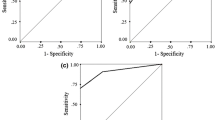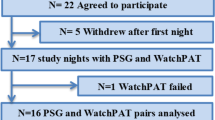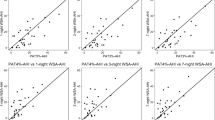Abstract
Obstructive sleep apnea (OSA) is a risk factor for perioperative complications, but many OSA patients present undiagnosed. While polysomnography (PSG) is the “gold standard” for diagnosis, its application is technology-intense, time-consuming, expensive, and requires specialists, often delaying surgery. Thus, miniaturized devices were developed for OSA screening aimed at ruling out major OSA while measuring a lesser number of biological signals. We evaluated the accuracy of a photoplethysmography (PPG)-based device for OSA detection. 48 patients with established or strongly suspected (STOP-Questionnaire) OSA scheduled for surgery underwent in their preoperative nights parallel recordings by PPG and a classic polygraphy (PG) devices (SomnoLab2®). We compared the diagnostic accuracy of the PPG in diagnosing mild [Apnea-/Hypopnea-Index (AHI) 5–14 events/h] and moderate-to-severe OSA (AHI > 15). PPG and PG-derived AHI correlated significantly (r = 0.85, p < 0.0001) and high area under curve (AUC) in receiver operator characteristics (ROC) values were seen for both AHI thresholds (0.93 and 0.95, respectively). For an AHI > 5, sensitivity was 100%, specificity 44%, positive predictive value (PPV) 62%, negative predictive value (NPV) 100%, likelihood ratio (LHR) 1.79, and Cohen κ was 0.43. For an AHI > 15, sensitivity was 92%, specificity 77%, PPV 60%, NPV 96%, LHR 4.04, and Cohen κ was 0.59. In a typical perioperative cohort of confirmed and suspected OSA patients, PPG reliably detected OSA patients while showing some false-positive results. Such devices are helpful for preoperative OSA screening.



Similar content being viewed by others
References
Malhotra A, White DP. Obstructive sleep apnoea. Lancet. 2002;360:237–45.
Young T, Palta M, Dempsey J, Skatrud J, Weber S, Badr S. The occurrence of sleep-disordered breathing among middle-aged adults. N Engl J Med. 1993;328:1230–5.
Fassbender P, Herbstreit F, Eikermann M, Teschler H, Peters J. Obstructive sleep apnea—a perioperative risk factor. Dtsch Arztebl Int. 2016;113:463–9.
Heinzer R, Vat S, Marques-Vidal P, Marti-Soler H, Andries D, Tobback N, et al. Prevalence of sleep-disordered breathing in the general population: the HypnoLaus study. Lancet Respir Med. 2015;3:310–8.
Finkel KJ, Finkel KJ, Searleman AC, Searleman AC, Tymkew H, Tymkew H, et al. Prevalence of undiagnosed obstructive sleep apnea among adult surgical patients in an academic medical center. Sleep Med. 2009;10:753–8.
Memtsoudis S, Liu SS, Ma Y, Chiu YL, Walz JM, Gaber-Baylis LK, et al. Perioperative pulmonary outcomes in patients with sleep apnea after noncardiac surgery. Anesth Analg. 2011;112:113–21.
Fortier J, Chung F, Su J. Unanticipated admission after ambulatory surgery—a prospective study. Can J Anesth. 1998;45:612–9.
Liao P, Yegneswaran B, Vairavanathan S, Zilberman P, Chung F. Postoperative complications in patients with obstructive sleep apnea: a retrospective matched cohort study. Can J Anesth. 2009;56:819–28.
American Society of Anesthesiologists Task Force on Perioperative Management of patients with obstructive sleep apnea. Practice guidelines for the perioperative management of patients with obstructive sleep apnea: an updated report by the American Society of Anesthesiologists Task Force on Perioperative Management of patients with obstructive sleep apnea. Anesthesiology. 2014;120:268–86.
Stierer TL, Stierer TL, Wright C, Wright C, George A, George A, et al. Risk assessment of obstructive sleep apnea in a population of patients undergoing ambulatory surgery. J Clin Sleep Med. 2010;6:467–72.
Epstein LJ, Kristo D, Strollo PJ, Friedman N, Malhotra A, Patil SP, et al. Clinical guideline for the evaluation, management and long-term care of obstructive sleep apnea in adults. J Clin Sleep Med. 2009;5:263–76.
AARC-APT (American Association of Respiratory Care-Association of Polysomnography Technologists) clinical practice guideline. Polysomnography. Respir Care. 1995;40:1336–43.
Netzer NC, Stoohs RA, Netzer CM, Clark K, Strohl KP. Using the Berlin Questionnaire to identify patients at risk for the sleep apnea syndrome. Ann Intern Med. 1999;131:485–91.
Chung F, Yegneswaran B, Liao P, Chung SA, Vairavanathan S, Islam S, et al. STOP questionnaire: a tool to screen patients for obstructive sleep apnea. Anesthesiology. 2008;108:812–21.
Chung F, Subramanyam R, Liao P, Sasaki E, Shapiro C, Sun Y. High STOP-Bang score indicates a high probability of obstructive sleep apnoea. Br J Anaesth. 2012;108:768–75.
Sforza E, Chouchou F, Pichot V, Herrmann F, Barthélémy JC, Roche F. Is the Berlin questionnaire a useful tool to diagnose obstructive sleep apnea in the elderly? Sleep Med. 2011;12:142–6.
Silva GE, Vana KD, Goodwin JL, Sherrill DL, Quan SF. Identification of patients with sleep disordered breathing: comparing the four-variable screening tool, STOP, STOP-Bang, and Epworth Sleepiness Scales. J Clin Sleep Med. 2011;7:467–72.
Kapur VK, Auckley DH, Chowdhuri S, Kuhlmann DC, Mehra R, Ramar K, et al. Clinical practice guideline for diagnostic testing for adult obstructive sleep apnea: an American Academy Of Sleep Medicine clinical practice guideline. J Clin Sleep Med. 2017;13:479–504.
Gjevre JA, Taylor-Gjevre RM, Skomro R, Reid J, Fenton M, Cotton D. Comparison of polysomnographic and portable home monitoring assessments of obstructive sleep apnea in Saskatchewan women. Can Respir J. 2011;18:271–4.
Erman MK, Stewart D, Einhorn D, Gordon N, Casal E. Validation of the ApneaLink for the screening of sleep apnea: a novel and simple single-channel recording device. J Clin Sleep Med. 2007;3:387–92.
Claman D, Murr A, Trotter K. Clinical validation of the Bedbugg™ in detection of obstructive sleep apnea. Otolaryngology. 2001;125:227–30.
Ballester E, Solans M, Vila X, Hernandez L, Quinto L, Bolivar I, et al. Evaluation of a portable respiratory recording device for detecting apnoeas and hypopnoeas in subjects from a general population. Eur Respir J. 2000;16:123–7.
Sommermeyer D, Zou D, Grote L, Hedner J. Detection of sleep disordered breathing and its central/obstructive character using nasal cannula and finger pulse oximeter. J Clin Sleep Med. 2012;8:527–33.
Romem A, Romem A, Koldobskiy D, Scharf SM. Diagnosis of obstructive sleep apnea using pulse oximeter derived photoplethysmographic signals. J Clin Sleep Med. 2014;10:285–90.
Barak-Shinar D, Amos Y, Bogan RK. Sleep disordered breathing analysis in a general population using standard pulse oximeter signals. Sleep Breath. 2013;17:1109–15.
Li Y, Gao H, Ma Y. Evaluation of pulse oximeter derived photoplethysmographic signals for obstructive sleep apnea diagnosis. Medicine. 2017;96:e6755.
Iber C, Ancoli-Israel S, Chesson AL, Quan SF. Das AASM-Manual zum Scoring von Schlaf und assoziierten Ereignissen. Heidelberg: Steinkopff; 2008.
Allen J. Photoplethysmography and its application in clinical physiological measurement. Physiol Meas. 2007;28:R1–R39.
Kaw R, Pasupuleti V, Walker E, Ramaswamy A, Foldvary-Schafer N. Postoperative complications in patients with obstructive sleep apnea. Chest Am Coll Chest Phys. 2012;141:436–41.
Acknowledgements
We thank Weinmann Geräte für Medizin GmbH & Co. KG, Hamburg, Germany, for supporting this study by lending us five portable polygraphy devices.
Author information
Authors and Affiliations
Corresponding author
Ethics declarations
Conflict of interest
The authors declare that they have no conflict of interest.
Ethical approval
All procedures performed in studies involving human participants were in accordance with the ethical standards of the institutional and/or national research committee and with the 1964 Helsinki declaration and its later amendments or comparable ethical standards.
Informed consent
Informed consent was obtained from all individual participants included in the study.
Rights and permissions
About this article
Cite this article
Faßbender, P., Haddad, A., Bürgener, S. et al. Validation of a photoplethysmography device for detection of obstructive sleep apnea in the perioperative setting. J Clin Monit Comput 33, 341–345 (2019). https://doi.org/10.1007/s10877-018-0151-2
Received:
Accepted:
Published:
Issue Date:
DOI: https://doi.org/10.1007/s10877-018-0151-2




